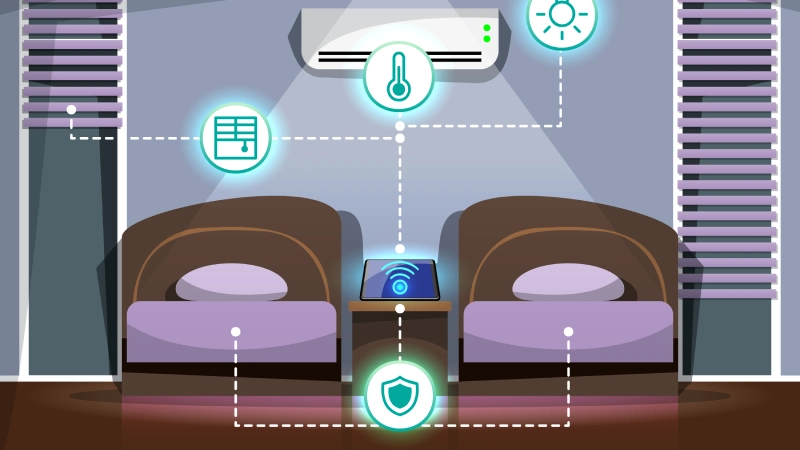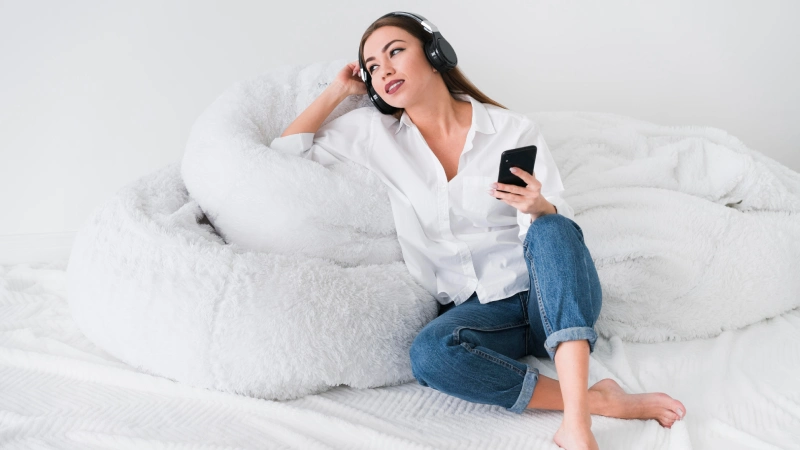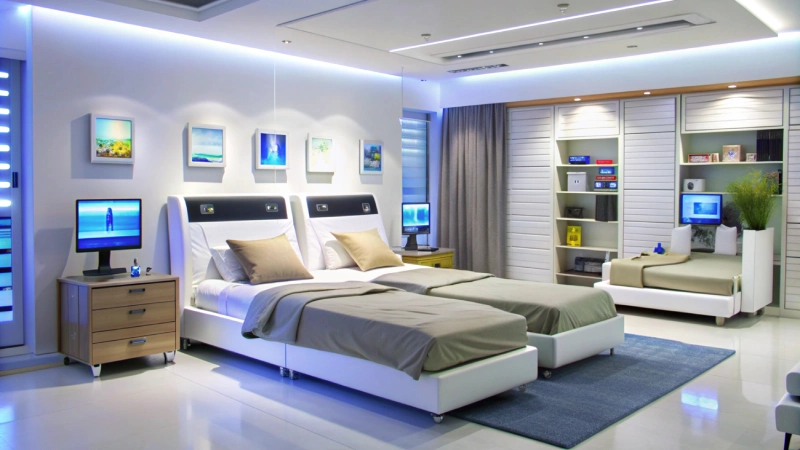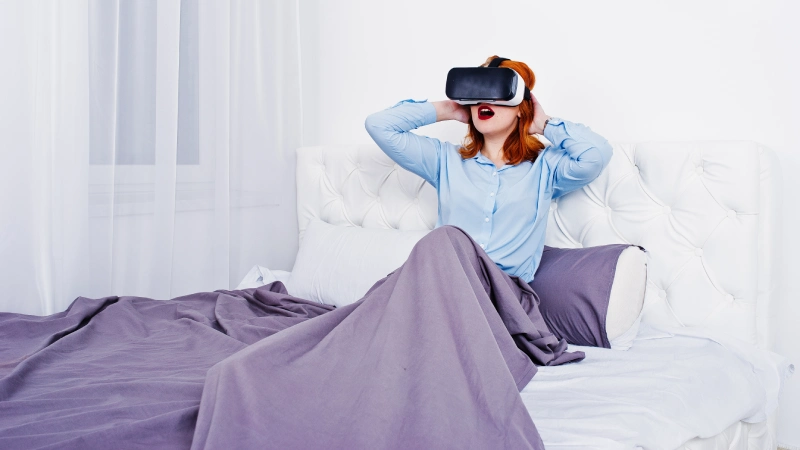Table of Contents
Highlights
- Explains how smart grid mattresses use climate control, adjustable firmness, and built-in sensors to improve sleep.
- Reviews how wearables and under-mattress pads track heart rate, breathing, and sleep stages for useful insights.
- Discusses the benefits and drawbacks of tech-enhanced sleep tools, including accuracy, privacy, and cost.
- Highlights future trends such as multi-zone temperature control, AI-driven recommendations, and deeper health integration.
In recent years, the market for tech-driven sleep solutions has grown rapidly. This change demonstrates a deeper understanding of the importance of quality sleep for both physical and mental health. Smart mattresses and sleep trackers are now among the most popular items in this field.
Unlike traditional beds, these products use sensors, responsive materials, and AI-powered insights to create a personalized sleep experience. From regulating temperature to tracking sleep cycles, today’s smart sleep tools aim to do more than provide comfort—they help you optimize your lifestyle. They offer more than just comfort. Many aim to give useful insights about sleep patterns and environmental factors, assisting users to improve their routines and surroundings for better rest.
What Smart Mattresses and Sleep Trackers Do
Smart mattresses integrate technology directly into the bed to improve comfort and track the sleeper’s health data. Features include temperature regulation, dual-zone heating or cooling, adjustable firmness, and built-in sensors to monitor movement, breathing, and heart rate. Some models even change their support levels during the night to help maintain a good posture or reduce snoring. Sleep trackers focus on measurement.

They record variables such as sleep duration, efficiency, and stages, including light, deep, and REM sleep, along with physiological metrics like heart rate variability or respiratory patterns. While wearables like rings or watches have dominated this area, non-wearable options like under-mattress pads or toppers are becoming more popular because they are more comfortable and less noticeable.
Leading Smart Mattress Innovations
Among the standout smart mattresses is the Bryte Balance Smart Bed. It uses air-filled coils and embedded sensors to automatically adjust firmness based on movement. This system allows the mattress to change with a sleeper’s position during the night. It aims to provide support and reduce disruptions. Tempur-Pedic’s TEMPUR-ActiveBreeze Smart Bed is another high-end option. It combines memory foam with climate control technology.
Each side of the bed can be heated or cooled independently. This feature makes it particularly attractive to couples with different comfort needs. Sleep Number’s p6 Smart Bed offers a similar approach. It has side-by-side adjustability and built-in sleep tracking. These models show how far the industry has moved beyond traditional foam or spring designs. They transform the mattress into a responsive, data-gathering platform.

Advances in Sleep Tracking Technology
Sleep tracking has progressed from simple wristbands to advanced systems that can analyze several physical signals. Wearable devices, such as Oura rings and Apple Watches, remain popular because they are convenient and integrate well with health apps. However, non-wearable sensors, such as Withings’ under-mattress pads, are gaining popularity.
These mats can measure heart rate, breathing, and even detect snoring or disturbances without needing the user to wear anything while sleeping. While trackers are good at estimating total sleep time and telling whether a person is awake or asleep, they struggle to accurately identify specific sleep stages. While stage accuracy isn’t perfect, they excel at identifying long-term sleep patterns—like how exercise, diet, or room temperature affect your rest.
Benefits and Drawbacks of Smart Sleep Tools
The benefits of smart mattresses include personalized comfort, climate control, and the convenience of built-in sensors that lessen the need for extra devices. These beds are especially useful for couples who want different firmness or temperature settings, as well as for individuals looking for data to help improve their sleep. However, the downsides are significant. High prices, maintenance needs, and the risk of sensor malfunctions or connectivity problems can take away from the experience.
Smart mattresses are also heavier and more complicated to set up than traditional beds. Sleep trackers, while generally cheaper and more flexible, have their own issues. Accuracy can differ greatly, privacy concerns come up with storing sensitive health information, and wearables can be uncomfortable or need frequent charging.
Summarizing
Benefits
- Personalized comfort (temperature + firmness control).
- Sleep data insights for long-term health.
- Great for couples with different comfort needs.
- The smart grid mattress improves airflow and relieves pressure, reducing tossing and turning.
Drawbacks
- High cost compared to traditional mattresses.
- Sensor malfunctions or connectivity issues.
- Privacy concerns with sensitive health data.
- Wearables can be uncomfortable or need frequent charging.

Choosing the Right System
Selecting the best tech-enhanced sleep solution depends on a person’s priorities. Someone who sleeps hot might benefit most from a mattress with cooling features or dual-zone temperature control. Another person may value adjustable firmness to relieve back pain. For those more interested in data than hardware upgrades, a high-quality tracker, especially a non-wearable sensor, may be enough.
When choosing between a smart mattress or a tracker:
- Hot sleepers → dual-zone climate control mattresses.
- Back-pain sufferers → adjustable firmness or a smart grid mattress.
- Data lovers → non-wearable sleep trackers for long-term insights.
Trial periods, warranties, and app quality should be considered since it can take weeks to find out if a mattress or tracker really improves sleep quality. Connectivity requirements are also important; some smart beds need constant power or Wi-Fi to work properly. The quality of the accompanying app is also crucial. It should present data clearly and provide practical recommendations instead of overwhelming the user with numbers.
Current Market Examples
Products like the Withings Sleep Tracking Mat showcase the non-wearable trend. Positioned under the mattress, it tracks movement, breathing, and heart rate without direct contact, sending the results to an app that offers nightly summaries and long-term sleep patterns.
The Withings Sleep-Pad Under-Mattress Sensor serves a similar purpose but highlights environmental factors such as noise and temperature.

On the mattress side, high-end options like the SFE Adjustable Bed with Cooling Memory-Foam Mattress or the Nectar Queen Adjustable Base Mattress Combo focus on customizable support, climate control, and overall comfort. They sometimes leave advanced tracking to separate devices. These examples illustrate the wide range of choices available today, from add-on pads to fully integrated systems.
Trends Shaping the Future of Sleep Tech
Emerging trends indicate more personalization and integration. Multi-zone temperature control is becoming standard. This feature allows different parts of the bed to be heated or cooled separately. Air-chamber mattresses that adjust firmness on demand are getting quieter and more reliable. In sleep tracking, developers are including a broader range of physiological signals, like skin temperature, blood oxygen levels, and heart rate variability. This helps improve stage detection and provides early warnings for conditions such as sleep apnea. Another trend is toward wellness ecosystems.
These systems combine sleep data with diet, stress, and exercise information to create holistic recommendations. Artificial intelligence is beginning to predict nights of poor sleep and suggest changes before issues arise. It might recommend adjusting the room temperature or using relaxation techniques. As these systems develop, they will likely become more affordable, durable, and easier to maintain, making them accessible to more people beyond early adopters.

Conclusion: Smarter Sleep for a Healthier Life
Smart mattresses and sleep trackers make a big difference in changing sleep from just a necessary part of life to something we can actively improve. A smart grid mattress combines comfort, breathability, and adaptive support, while trackers provide the data insights needed to refine habits. By combining comfort, control over the environment, and data insights, these tools help users identify the habits and conditions that lead to better sleep.
However, they are not perfect solutions; factors like accuracy, cost, and the willingness to change one’s routine affect how well they work. For most people, the best approach is to select products that align with their comfort needs, health goals, and budget. They can then use the data over time to adjust their environment and habits. By doing this, tech-enhanced sleep technology solutions can lead to better nights and healthier, more productive days.